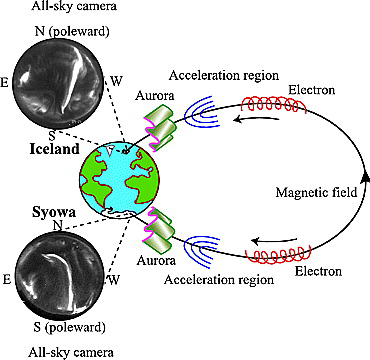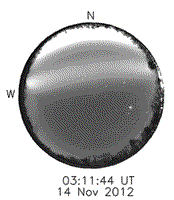All-Sky Imager
Besides radio probing, signatures of ionospheric perturbations can also be detected using instruments that exploit the visible portion of electromagnetic spectrum. At high latitude, these signatures manifest as amazing aurorae and, during the night time, they can be visible to the naked eye.
Far from the poles, the optical emissions can be revealed only using a specialised instrument, such as an All-Sky Imager. The emissions occurring at middle latitudes are either related to severe geomagnetic storms (still associated to auroral events) or induced by forcing from the lower atmosphere. On the other hand, the low-light-level emissions detected at lower latitudes are related to the shape of the Earth’s magnetic field and their occurrence is not always affected by geomagnetic storms.
In the last decades, the interest of the scientific community in the effect of the litosphere-atmosphere-ionosphere coupling is increasing and the all-sky imager is a valuable instrument to investigate also the effect of significant lithospheric events (large earthquakes, tsunamis, volcanic eruptions, etc.) propagating up the ionized layer of the atmosphere.
Pairs of all-sky imagers can be deployed at magnetically conjugate points on the Earth’s surface, where the observing sites sit at both ends of the same geomagnetic field line. This allows studying the ionospheric disturbances conjugated by the geomagnetic field, but influenced by the opposite seasonal conditions.

Figure 1. Illustration of the use of ASI images to study the ionosphere at the geomagnetic field lines footprint. (From Sato et al, 2005, doi: 10.1029/2005GL023710)
The geomagnetic conjugacy offers an amazing opportunity to investigate the equatorial spread-F, medium scale travelling ionospheric disturbances and stable auroral red arcs, characterizing the low, middle and sub-auroral ionosphere, respectively.
The stable auroral red arcs are not so well-known as the northern or southern lights, but they are more stable and maintain their shape in time. They are only observed using the all-sky imager at a wavelength of 6300 Å, which corresponds to an emission line of oxygen.
Boston University carried out the first optical studies of such kind of ionospheric structures deploying a network of all-sky imagers specifically designed and realized by its team. An example of SAR arcs observed by the Boston University ASI is given in figure 2.
INGV, one of the PITHIA-NRF nodes, will deploy an all-sky imager build by Boston University in Gibilmanna, a location close to Palermo, in Sicily, Italy. The future observing site will form a geomagnetic conjugate pair with the ASI already operating in Sutherland, South Africa.
 Figure 2. A stable auroral red arc observed from the Boston University all-sky imager installed at Millstone Hill, USA. (Adapted from Mendillo et al., 2016, doi: 10.1002/2015JA021722)
Figure 2. A stable auroral red arc observed from the Boston University all-sky imager installed at Millstone Hill, USA. (Adapted from Mendillo et al., 2016, doi: 10.1002/2015JA021722)
